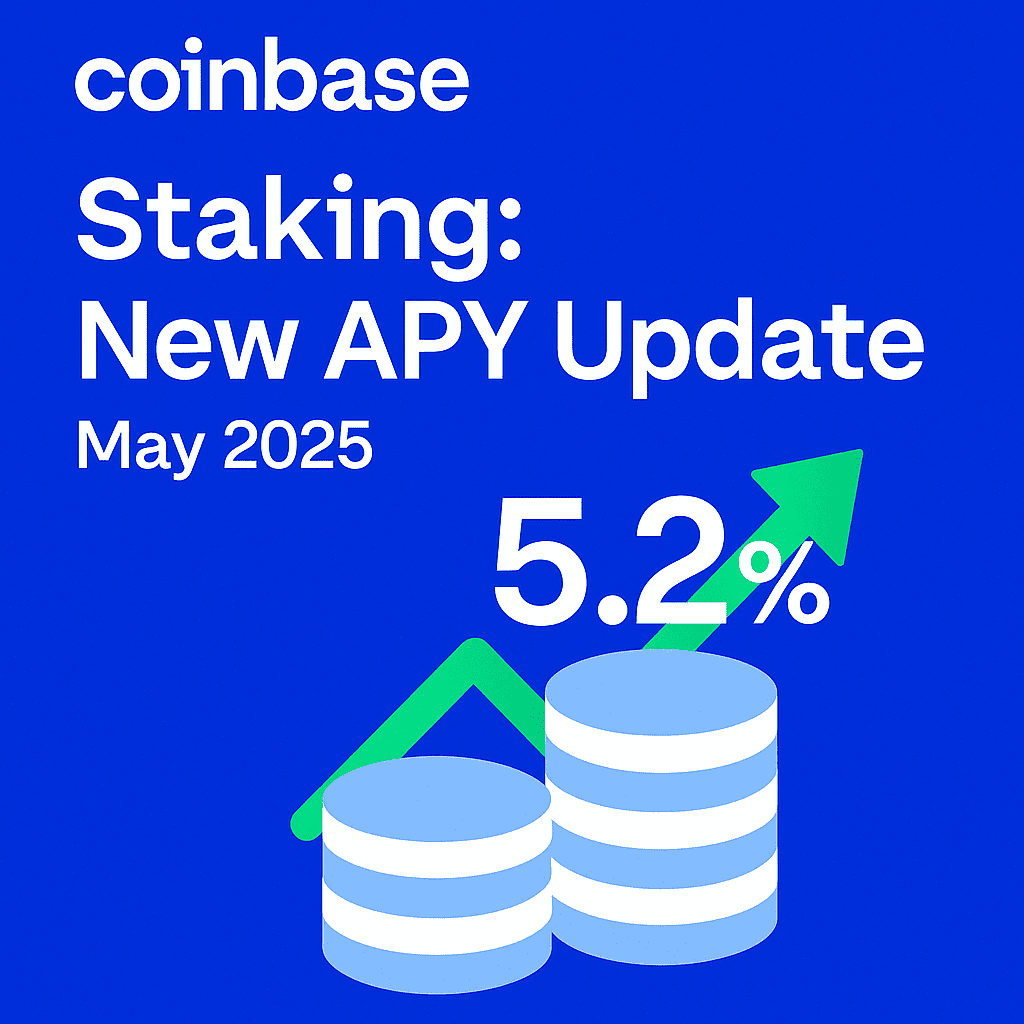Coinbase Staking: New APY Update (May 2025)
By Abhishek Chandravanshi

1. Why This APY Update Is Different in May 2025
Coinbase has updated its staking rates before—but this time, it’s not just a quiet backend tweak. May 2025 marks a shift in how rewards are calculated and shared. For the first time in nearly two years, Coinbase has begun passing more validator earnings to end users, responding to growing pressure from competitors like Kraken, Binance (international), and liquid staking protocols such as Lido and Rocket Pool.
While Coinbase staking is often considered “low-touch,” it now rewards users better for their trust. The new APY figures indicate Coinbase’s own validators have improved performance, and some operational costs have come down—allowing more yield to flow to you.
2. Updated APY Breakdown: ETH, SOL, ADA, and More (May 2025)
Let’s look at the newly updated staking APYs for top tokens on Coinbase:
| Token | APY (as of May 2025) | Lockup Period | Staking Type |
|---|---|---|---|
| Ethereum (ETH) | 5.2% | Unlocked (post-Shanghai) | Native staking |
| Solana (SOL) | 6.4% | ~2–4 days unlock | Native staking |
| Cardano (ADA) | 4.1% | Instant unlock | Delegation-based |
| Tezos (XTZ) | 4.8% | ~4–5 days | Delegation |
| Cosmos (ATOM) | 7.0% | 21-day unlock | Delegation |
| Algorand (ALGO) | 3.6% | No lockup | Passive earning |
This update reflects real-time validator yields, minus Coinbase’s fee cut (typically ~25%). But thanks to improved performance and uptime, the net reward to users has gone up in most cases.
3. What’s Driving the Change?
Coinbase’s May 2025 APY bump isn’t random. It’s driven by three key trends:
🧠 1. Validator Optimization
Coinbase has silently upgraded its infrastructure, improving block proposal frequency and uptime. The result? More staking rewards.
🔓 2. Post-Shanghai Ethereum Withdrawals
Now that Ethereum withdrawals are unlocked, Coinbase allows unstaked ETH withdrawals, making users feel safer—encouraging more people to stake, which reduces per-token costs.
💰 3. Rising DeFi Competition
DeFi platforms now offer liquid staking with 7–9% APY. Coinbase had to respond by raising base rates and optimizing backend performance to stay competitive.
4. Coinbase vs Kraken vs DeFi in May 2025
Here’s how Coinbase’s new staking APYs compare to other popular platforms in the U.S.:
| Platform | ETH APY | SOL APY | ADA APY | User Experience |
|---|---|---|---|---|
| Coinbase | 5.2% | 6.4% | 4.1% | Simple, fully custodial |
| Kraken | 5.5% | 6.7% | 4.3% | Slightly higher APY, similar UX |
| Lido (via MetaMask) | 7.1% | — | — | DeFi, liquid staking |
| Rocket Pool | 6.8% | — | — | DeFi, more control |
While DeFi rates are higher, many U.S. users still prefer Coinbase’s legal clarity, FDIC-backed USD holdings, and ease of use—especially for long-term staking.
5. Real Earnings: What You Get with $1K, $5K, and $10K Staked
Let’s break down real staking returns based on the updated APYs:
💸 $1,000 in ETH at 5.2% APY
- 1 year: ~$52 earned
- After fees: ~$39 (Coinbase takes 25%)
💸 $5,000 in SOL at 6.4% APY
- 1 year: ~$320 earned
- After fees: ~$240
💸 $10,000 in ADA at 4.1% APY
- 1 year: ~$410 earned
- After fees: ~$307.5
Want to test more values?
👉 Try our Crypto Staking Returns Calculator
6. What About Fees, Lockups, and Risks?
While APY is important, here are 3 hidden variables to understand:
1. Staking Fees
Coinbase takes a ~25% cut of your staking rewards. This is higher than Kraken (~15%) or Lido (~10%).
2. Unstaking Periods
Some assets (e.g., ATOM, SOL) have natural protocol-level unbonding periods. Coinbase doesn’t shorten them.
3. No Insurance on Staked Funds
While USD is FDIC-insured, crypto—even when staked—isn’t. Coinbase protects your custody, not your yield.
7. Who Should Stake on Coinbase in 2025?
Coinbase staking is ideal for:
✅ Beginner crypto holders
✅ Passive investors in the U.S.
✅ Long-term ETH, SOL, ADA holders
✅ Those who don’t want to run nodes or use DeFi tools
It’s not ideal for:
❌ Yield maximizers
❌ DeFi-native users
❌ Those staking very large amounts (fees eat into ROI)
8. Strategy Tips: How to Maximize Coinbase Staking
If you choose Coinbase, here’s how to optimize:
- Pick the highest APY tokens (e.g., Cosmos over Cardano)
- Diversify across assets to reduce risk
- Use our staking calculator before committing large sums
- Avoid frequent unstaking (some assets have penalties or delays)
9. Final Thoughts: Is Coinbase Staking Still Worth It in 2025?
Yes—if simplicity and compliance matter more than max rewards.
With this May 2025 APY update, Coinbase has shown it’s willing to share more with stakers. While it won’t outcompete DeFi or power users, it remains one of the safest, easiest entry points into staking for U.S. investors.
If you’re staking under $25K and want minimal hassle, Coinbase remains a strong option in 2025. Just keep your expectations grounded: 4–6% APY after fees is realistic.
🔎 FAQs: Coinbase Staking (May 2025 Update)
Q1. Can U.S. users still stake ETH on Coinbase?
Yes. As of May 2025, U.S. users can legally stake ETH on Coinbase, with no new restrictions. Withdrawals are unlocked.
Q2. What’s the current ETH APY on Coinbase?
ETH staking offers 5.2% APY in May 2025, down slightly from DeFi platforms, but competitive among centralized exchanges.
Q3. How long does unstaking take?
It varies. ETH is now liquid post-Shanghai, but ATOM has a 21-day period, and SOL takes 2–4 days.
Q4. Is staking income on Coinbase taxable?
Yes. The IRS considers staking rewards as taxable income. See our full guide:
👉 IRS Rules for Crypto Staking Income (Explained Simply)
Q5. Can I compound my rewards automatically?
Currently, Coinbase does not auto-compound. You must manually restake your rewards.
📚 Further Reading on CryptoTrendd:
- 🔗 Highest Paying Staking Exchanges Right Now (May 2025)
- 🔗 Coinbase vs Kraken for ETH Staking
- 🔗 How Much You Can Earn Staking $1,000
- 🔗 Top Liquid Staking Tokens for U.S. Users
Conclusion:
Coinbase’s May 2025 staking APY update gives long-term holders better returns than before — with the same secure, easy-to-use experience. While it won’t win a yield-max contest, it delivers stable returns with low friction, making it one of the best passive income options for average U.S. crypto investors today.
What crypto asset are you most excited to stake on Coinbase in May 2025, and why?Leave a Comment
